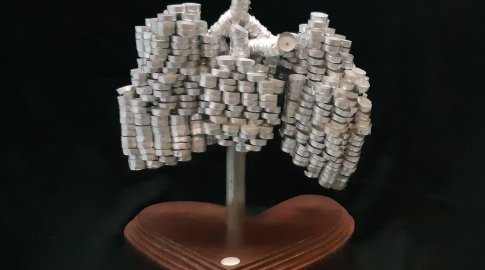Delving into diuretics
Here, Consultant Pharmacist Neil Hamilton explains the role of ‘water tablets’ in managing PH.
If you have PH, you are advised to keep a close eye on signs of fluid retention, as these can be an indication of heart failure and worsening PH. Fluid retention, also sometimes called oedema, may be widespread around the body (especially in younger patients) but is most commonly seen around the feet and ankles. Whilst invisible from the outside, heart failure can cause fluid to build up around the lungs, causing shortness of breath.
In order to keep their oedema to a minimum, many, but not all, people with PH are prescribed diuretics, or ‘water tablets’. Diuretics work by causing the kidneys to increase the amount of salt and sodium that is filtered out of the blood and into the urine. When these salts are filtered out of the blood by the kidneys, water is also drawn alongside (like a magnet). By removing the excess fluid, they make it easier for the heart to pump blood around the body. This is useful in heart failure where the pumping mechanism of the heart is less effective
Diuretics commonly used in PAH include furosemide and bumetanide (loop diuretics) bendroflumethaizide (a thiazide diuretic) and spironolactone, epleronone and amiloride (potassium-sparing diuretics).
Different types of diuretic may be combined if oedema persists with only one. For example, loop diuretics such as furosemide are often combined with potassium-sparing diuretics such as spironolactone. This ensures that potassium levels are kept at safe levels in the blood. Potassium is very important, not least to maintain a normal heart rhythm.
Anyone on diuretics will need regular blood tests to closely check kidney function and salt levels (including potassium). This is even more crucial if thiazide and loop diuretics are combined, or you are prescribed high doses of any of these medicines. This is because of the risk of putting strain on the kidneys in order to treat the heart failure. Doctors will prescribe the lowest effective dose that keeps the swelling down, in order to try and avoid these complications if possible.
Whilst essential for many of you with PH, diuretics are not without side effects, usually as a result of the salt level disturbances. On starting someone on diuretics, we will discuss increased thirst, headache, low blood pressure, fatigue and gastrointestinal symptoms. Unfortunately, some diuretics can cause increased sensitivity to sunlight, so extra care is needed on sunny days. We will also make it clear that diuretics will make you go to the toilet more than normal (which is necessary to lose the excess fluid). In order not to ‘undo’ the effectiveness, we also discuss the need for drinking a sensible amount of fluid each day. It is also sensible to watch for sudden changes in weight, as this might indicate worsening heart failure.
As diuretics make you produce more urine, for very practical reasons it is recommended that these are taken in the morning (for once-daily dosing) with a second dose at lunchtime if prescribed. In exceptional circumstances, it is possible to make minor adjustments to the time at which you take your diuretics. They can be taken later in the day, to make it easier to deal with car journeys or important appointments. If you miss your dose prior to an appointment with a doctor or nurse, you must tell them of this change, or otherwise they may think that the diuretic is not working properly.
In summary, diuretics are fairly commonly prescribed in PH, but doses are kept to a minimum in order to avoid side effects and putting strain on the kidneys. You should keep a close eye on your own fluid status at home, which can be done by periodically weighing yourself on bathroom scales. If lots of fluid is allowed to build unchecked, it can result in the need for higher doses, frequent blood tests and even hospitalisation. As always, your local pharmacist or the team at the specialist centre will be happy to give advice regarding diuretics, dosing, blood tests and how side effects can be managed.
















